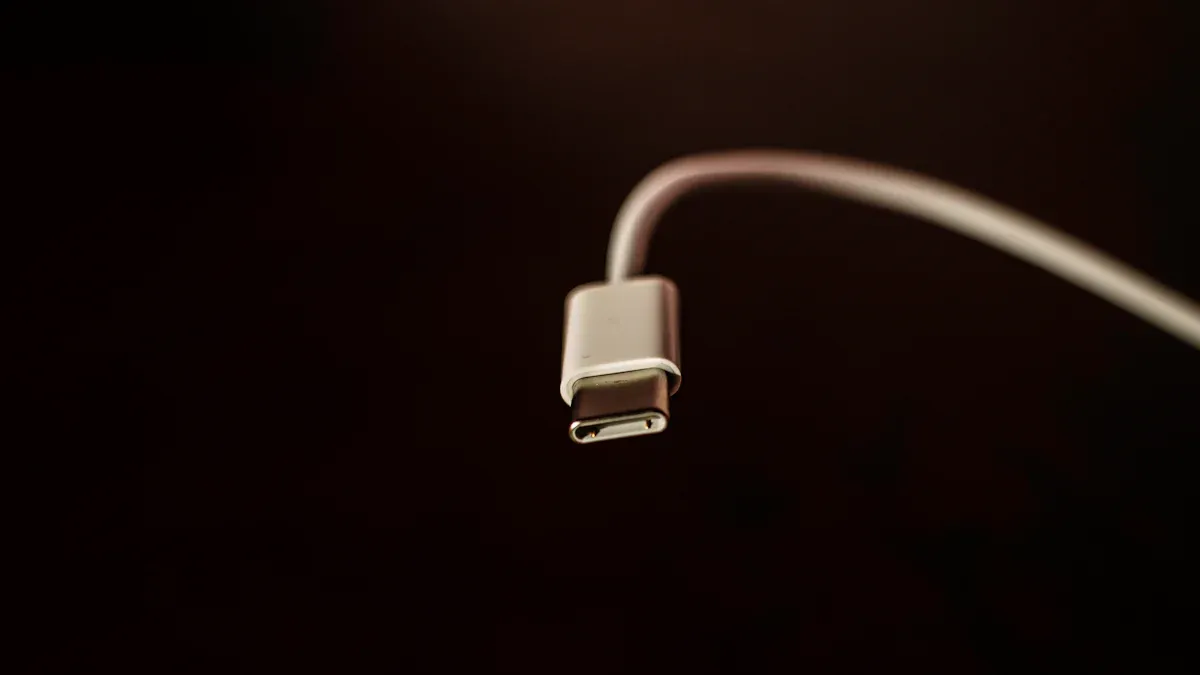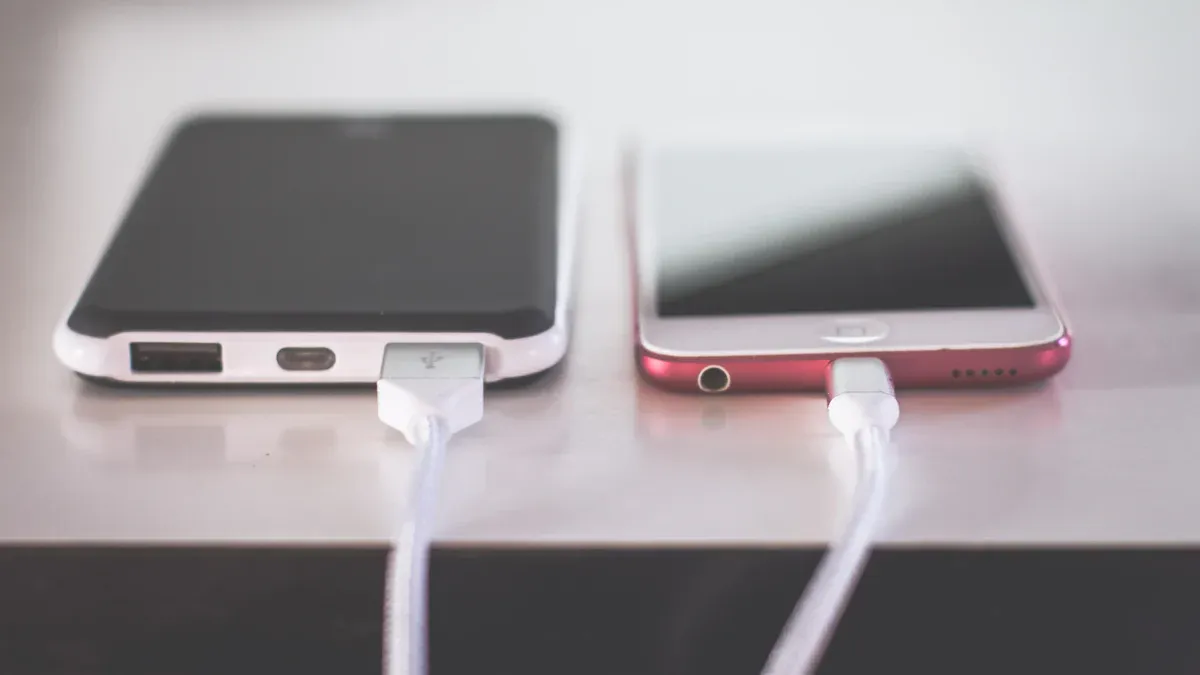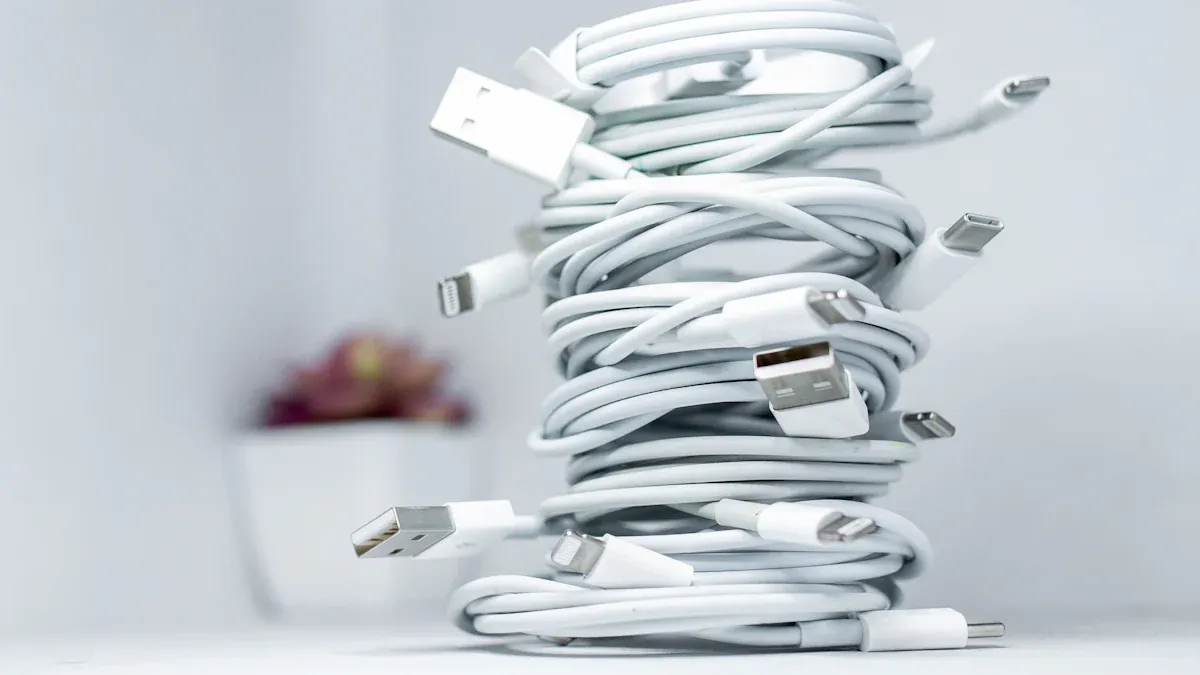Have you ever grabbed your iPhone, only to realize it didn’t charge overnight? It’s frustrating, right? The cable you use plays a huge role in this. Apple iPhone cables aren’t just about connecting your phone to power; they’re about speed, durability, and protecting your device.
High-quality lightning cables make a difference. They use better materials, which last longer and work better. Thicker wires (lower AWG) reduce resistance, meaning faster charging. On the other hand, cheap cables can slow everything down. They limit your charger’s output and create bottlenecks, especially when paired with fast chargers. Even the length matters—longer cables often deliver less power.
If you want a cable that charges quickly, lasts longer, and keeps your iPhone safe, choosing the right one is essential.
Key Factors to Consider When Choosing Apple iPhone Cables
Length and Portability
When picking a lightning cable, length matters more than you might think. A short cable works great if you’re charging your iPhone at a desk or in your car. It keeps things tidy and easy to manage. But if you’re lounging on the couch or your outlet is far from your bed, a longer cable can save you from awkward stretches.
However, longer cables aren’t always better. They can tangle easily and may not deliver power as efficiently as shorter ones. If you travel often, look for a cable that’s compact and easy to pack. Some cables even come with straps or cases to keep them organized. Think about where and how you’ll use your cable most, and choose a length that fits your lifestyle.
Material and Build Quality
The material of your lightning cable plays a big role in how long it lasts. Cheap cables often fray or break after just a few months. You’ve probably seen those cables with exposed wires or bent connectors. That’s why choosing one made from durable material is so important.
Braided cables, for example, are tougher than standard plastic ones. They resist wear and tear, making them perfect for everyday use. Some cables even have reinforced connectors to prevent bending or snapping. If you want a cable that can handle constant plugging and unplugging, go for one with a sturdy build. It’s worth spending a little more for something that won’t let you down.
MFi Certification and Compatibility
You’ve probably seen the term “MFi” on some lightning cables. It stands for “Made for iPhone,” and it’s Apple’s way of certifying that a cable meets their standards. MFi certification isn’t just a fancy label—it’s a guarantee that the cable will work safely and efficiently with your iPhone.
Non-MFi cables might seem like a good deal, but they can cause problems. They might not charge your phone properly or could even damage it over time. Worse, some non-MFi cables stop working after a software update. Always check for MFi certification before buying a cable. It ensures compatibility with your iPhone and gives you peace of mind.
Charging and Data Transfer Speed
When it comes to your iPhone, speed matters. Whether you’re charging your device or transferring files, the right cable can make a huge difference. A high-quality lightning cable ensures faster charging performance and quicker data transfers, saving you time and frustration.
Let’s talk about charging speed first. Did you know that the Lightning connector can charge your iPhone up to 50% in just 30 minutes? That’s perfect for those moments when you’re in a rush. If you’re using a USB-C to Lightning cable with a compatible fast charger, you’ll notice even better results. USB-C cables can handle up to 100 watts of power, which is why they’re also used to charge laptops. This means you can rely on them for efficient and fast charging, whether it’s your phone or another device.
Data transfer speed is just as important, especially if you frequently move large files like videos or photos. USB 3.2 cables, for example, can transfer data at speeds of up to 20Gbps. That’s three times faster than older USB 3.0 cables. If you’re using USB4, you’ll get an incredible 40Gbps transfer rate. This is a game-changer for anyone who works with data-heavy tasks, like editing videos or backing up files. Faster speeds mean less waiting and more productivity.
Here’s a quick breakdown of what these technical benchmarks mean for you:
– USB4 offers blazing-fast data transfer rates of up to 40Gbps, making it ideal for large file transfers.
– USB-C cables deliver up to 100 watts of power, ensuring faster charging for your iPhone and other devices.
– Lightning cables paired with fast chargers can charge your iPhone up to 50% in just 30 minutes.
Choosing a cable with excellent charging and data transfer speed isn’t just about convenience. It’s about efficiency and making the most of your time.
Connector Type and Versatility
The type of connector your cable uses plays a big role in its versatility. For iPhones, the Lightning connector is the standard. It’s compact, easy to use, and works seamlessly with Apple devices. But if you’re looking for a cable that can do more, consider one with a USB-C connector on the other end. USB-C is incredibly versatile and works with a wide range of devices, from laptops to tablets.
One of the best things about USB-C is its ability to handle multiple tasks at once. For example, USB4 cables can support data transfer, charging, and even video output simultaneously. This makes them perfect for multitasking. If you’re someone who uses multiple devices, a USB-C to Lightning cable can simplify your setup. You won’t need to carry different cables for different gadgets.
Market studies also show that connector design impacts long-term use. For instance, ST connectors are popular in telecom applications because of their durability and adaptability. Their bayonet-style locking mechanism ensures a secure connection, reducing wear and tear over time. While ST connectors aren’t used for iPhones, the principle remains the same: a well-designed connector improves performance and extends the life of your cable.
Here’s why connector versatility matters:
– USB-C connectors work with a wide range of devices, making them a great choice for multitaskers.
– Lightning connectors are designed specifically for Apple devices, ensuring compatibility and reliability.
– High-quality connectors, like those with reinforced designs, last longer and perform better.
When choosing a cable, think about how you’ll use it. If you need something for travel, a USB-C to Lightning cable might be your best bet. For home use, a standard Lightning cable could be all you need. The right connector type ensures your cable works for you, not the other way around.
Best Lightning Cables for Speed and Durability
Best Overall Lightning Cable
If you’re looking for the best overall charger cable, the Anker USB-C to Lightning Cable is a standout choice. It combines speed, durability, and reliability, making it perfect for everyday use. This cable supports fast charge support, allowing you to power up your iPhone from 0% to 50% in just 30 minutes when paired with a compatible charger. That’s a lifesaver when you’re in a rush.
What makes this lightning cable overall the best? First, it’s MFi certified, so you know it’s safe for your iPhone. Second, it’s built with braided nylon, which is far more durable than standard rubber cables. In fact, tests show that this cable can withstand over 12,000 bends, ensuring it lasts for years. Plus, it’s available in multiple lengths, so whether you need a short cable for your desk or a longer one for your couch, Anker has you covered.
Comparative research by Wirecutter also highlights this cable as the top performer in speed and durability. It charges faster than most competitors and handles wear and tear like a pro. If you want a reliable, heavy-duty lightning cable that won’t let you down, this is the one to get.
Best for Durability
For those who need a cable that can handle heavy use, the Anker PowerLine Lightning Cable is the best premium charger cable for durability. This heavy-duty lightning cable is designed to withstand the toughest conditions. It features reinforced stress points and a double-braided nylon exterior, making it nearly indestructible. Whether you’re constantly plugging and unplugging or bending the cable at odd angles, this one can take it.
Long-term durability studies back up its reputation. While many cables fail after just a few hundred bends, the Anker PowerLine can survive over 10,000 bends. That’s equivalent to years of daily use. It’s also MFi certified, so you don’t have to worry about damaging your iPhone.
Another great feature is its right-angle connector option. This design reduces stress on the cable and makes it more comfortable to use, especially when gaming or watching videos. If you need a heavy-duty lightning cable that’s built to last, this is your best bet.
Best for Fast Charging
When speed is your top priority, the Apple Lightning to USB-C Cable is the best long charger cable for fast charging. This cable supports fast charge support of up to 20W, allowing you to charge your iPhone to 50% in just 30 minutes. It’s perfect for those moments when you need a quick power boost before heading out.
In product testing, this cable ranked second only to the Anker USB-C to Lightning Cable in terms of charging speed. It’s also MFi certified, ensuring safe and efficient performance. The cable’s sleek design and premium build quality make it a great choice for anyone who values both style and functionality.
If you’re looking for a multi-connector lightning cable, this one pairs perfectly with Apple’s USB-C power adapters. It’s versatile enough to charge your iPhone, iPad, or even AirPods. Whether you’re at home, in the office, or on the go, this cable delivers fast and reliable performance every time.
Best for Travel
When you’re on the go, having a reliable and travel-friendly lightning cable can make all the difference. The Anker Powerline+ USB-C to C stands out as the best option for frequent travelers. It comes with a compact travel case and a Velcro strap, making it easy to keep your cable organized and tangle-free. Whether you’re packing for a weekend getaway or a long business trip, this cable ensures you won’t waste time untangling knots.
Other great options include the Anker Powerline II 3-in-1 and the JSaux USB-C to C cables. These also feature Velcro or silicone straps, which help keep your cables coiled neatly. Organization is key when you’re constantly on the move, and these cables deliver just that.
Pro Tip: Look for cables with built-in straps or cases. They not only save space but also prevent your cables from getting damaged during travel.
Why is this important? As urban populations grow and more people shift to public transport, having portable and organized accessories becomes essential. Here’s a quick look at some travel trends that highlight the need for travel-friendly designs:
| Statistic/Forecast | Description |
|---|---|
| Urban Population Growth by 2030 | Urban areas in Latin America will have 130 million more people than in 2010. |
| Decrease in Private Vehicle Use | Travel in private vehicles will decrease by 10% globally in the next decade. |
| Shift to Public Transport | Increased use of public transport, cycling, and walking as safer options. |
If you’re someone who travels often, investing in a cable like the Anker Powerline+ USB-C to C can save you time and hassle. Its durability and thoughtful design make it a must-have for anyone on the move.
Best Budget Option
You don’t have to spend a fortune to get a high-quality lightning cable. The UGREEN Nylon Braided Lightning Cable is an excellent budget-friendly choice. Despite its low price, this cable doesn’t compromise on quality. It’s MFi certified, ensuring compatibility with your iPhone and preventing issues like overheating or damage. Plus, its nylon-braided exterior adds durability, making it resistant to breaking and tangling.
Here are some reasons why this cable is a great pick:
– Durability: The braided design ensures it can withstand daily wear and tear.
– Performance: It supports fast charging and data transfer, so you won’t have to wait long to power up your device or move files.
– Affordability: You get all these features at a fraction of the cost of premium cables.
Budget cables like this one prove that you don’t need to sacrifice quality for price. If you’re looking for a reliable lightning charger cable that won’t break the bank, the UGREEN Nylon Braided Lightning Cable is a fantastic option.
Best Stylish Cable
Who says your lightning cable can’t be functional and stylish? The Native Union Belt Cable combines sleek design with top-notch performance. This cable features a unique braided pattern and comes in a variety of colors, so you can choose one that matches your personal style. It also includes a leather strap to keep it neatly coiled when not in use.
But this cable isn’t just about looks. It’s built to last, with reinforced connectors and a durable braided exterior. Whether you’re charging your iPhone at home or showing off your setup at a coffee shop, this cable adds a touch of sophistication to your tech accessories.
Here’s why the Native Union Belt Cable is worth considering:
– Design: Its premium materials and stylish finish make it stand out from standard cables.
– Functionality: It supports fast charging and data transfer, so you get both form and function.
– Convenience: The included leather strap keeps it organized and easy to carry.
If you want a lightning cable that performs well and looks great, the Native Union Belt Cable is the perfect choice. It’s proof that you can have both style and substance in one package.
Comparison of the Best Charging Cables for iPhone
Key Features Compared (e.g., length, material, speed, price, certification)
Choosing the right charging cable can feel overwhelming with so many options out there. To make it easier, let’s break down the key features of the best charging cables for your iPhone.
- Length: Short cables, like the Apple Lightning to USB-C, are perfect for desks or cars. They’re compact and easy to manage. Longer cables, such as the Anker PowerLine+, give you more flexibility. You can charge your phone from across the room without feeling restricted. Just remember, longer cables might not deliver power as efficiently as shorter ones.
- Material: Durability matters. Braided cables, like the Anker PowerLine Lightning Cable, last longer than standard plastic ones. They resist fraying and can handle daily wear and tear. If you want something stylish, the Native Union Belt Cable offers a premium braided design with reinforced connectors.
- Speed: Not all cables charge at the same speed. USB-C cables, like the Anker USB-C to Lightning Cable, deliver up to 100W of power and transfer data at 10Gbps. Lightning cables, on the other hand, offer speeds similar to USB 2.0, around 480Mbps. If speed is your priority, go for a USB-C to Lightning cable paired with a fast charger.
- Price: Budget-friendly options, like the UGREEN Nylon Braided Lightning Cable, prove you don’t need to spend a lot for quality. They’re affordable, durable, and MFi certified. Premium cables, like the Anker PowerLine+, cost more but offer better durability and performance.
- Certification: Always look for MFi certification. It ensures the cable is safe and compatible with your iPhone. Non-certified cables might damage your device or stop working after updates.
Pro Tip: If you need a cable for multitasking, choose one with a USB-C connector. It works with multiple devices and supports faster charging and data transfer.
By comparing these features, you can find the best charging cables that fit your needs. Whether you prioritize speed, durability, or price, there’s a perfect option for you.
Choosing the right cable for your iPhone isn’t just about convenience—it’s about protecting your device and saving time. High-quality lightning cables, like the Anker USB-C to Lightning Cable, deliver faster charging and last longer. They’re worth every penny. For example, a durable cable paired with a 20W charger can charge your iPhone 14 to 60% in just 30 minutes. Cheaper cables often slow this process down, wasting your time and energy.
Always look for MFi-certified options. They ensure compatibility and safety, so you won’t have to worry about damaging your phone. Investing in a reliable lightning cable now means fewer replacements later. It’s a small change that makes a big difference in the long run.
FAQ
What does MFi certification mean, and why is it important?
MFi stands for “Made for iPhone/iPad/iPod.” It’s Apple’s certification for accessories that meet their performance and safety standards. Using MFi-certified cables ensures your iPhone charges safely and efficiently without risking damage or compatibility issues.
Can non-MFi cables damage my iPhone?
Yes, non-MFi cables can harm your device. They might overheat, fail to charge properly, or even cause long-term damage to your iPhone’s battery. Always choose MFi-certified cables to avoid these risks and ensure reliable performance.
How do I know if a cable supports fast charging?
Look for USB-C to Lightning cables with “fast charge support” or “20W+ power delivery” on the packaging. Pair it with a compatible fast charger to charge your iPhone up to 50% in 30 minutes. Check for MFi certification for added assurance.
Are braided cables better than standard ones?
Braided cables are more durable. They resist fraying and handle daily wear better than plastic-coated cables. If you want a long-lasting option, go for a braided design. They’re perfect for heavy use and frequent travel.
How long should my iPhone cable be?
It depends on your needs. Short cables (3 feet) are great for desks or cars. Longer ones (6-10 feet) work well for charging from distant outlets. Keep in mind, longer cables may slightly reduce charging efficiency.
Pro Tip: For travel, choose a compact cable with a strap or case to stay organized.



